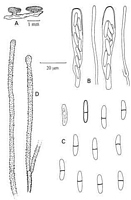|
 Perrotia alba Perrotia alba
BiostatusPresent in region - Indigenous. Endemic
Images (click to enlarge)
Caption: Figure 123. Perrotia alba, holotype. A. Apothecia. B. Asci and paraphyses.
C. Ascospores. D. Hairs. | 
Caption: FIG. 12. Perrotia alba. Habit sketch x15, details x660. |
Article: Dennis, R.W.G. (1961). Some inoperculate Discomycetes from New Zealand. Kew Bulletin 15(2): 293-320.
Article: Spooner, B.M. (1987). Helotiales of Australasia: Geoglossaceae, Orbiliaceae, Sclerotiniaceae, Hyaloscyphaceae. Bibliotheca Mycologica 116: 711 p.
Description: APOTHECIA scattered to gregarious, erumpent, short-stipitate or subsessile. DISC 1.0-1.5
mm diam. plano-concave, smooth, pale yellowish. RECEPTACLE shallow cupulate, with
incurved margin when dry, densely clothed with white hairs, sometimes discolouring yellowish
in dried apothecia. HAIRS hyaline, 3.0-3.5 µm diam., up to c. 200 µm long at the margin,
shorter on the receptacle, cylindric, obtuse, sometimes expanded at the apex, multiseptate,
walls thickened, particularly towards the base, granulate throughout and remaining so after
soaking in 5% KOH, or smooth at the extreme base. ASCI 60-67 x 8-9 µm, 8-spored,
clavate, tapered below to a short stalk, thin-walled, the apex broadly rounded.
ASCOSPORES hyaline, ellipso-cylindric, with ends rounded, sometimes slightly curved,
developing a single median or slightly sub-median septum, biseriately arranged, 12-17 x 3.5-4.5 µm, mean 14.9(SD 1.1) x mean 3.7(SD 0.2) µm. PARAPHYSES cylindric, obtuse, equal
to the asci, sometimes branched near the base, hyaline, 1.5-2.0(-2.5) µm diam.
SUBHYMENIUM composed of largely vertically arranged, somewhat interwoven hyphae
1.5-2.0 µm diam. in an irregular layer not distinctly differentiated from the medullary
excipulum. MEDULLARY EXCIPULUM up to 140 µm thick at the centre of the receptacle,
narrowed towards the margin and merging with the ectal excipulum, hyaline, composed of
loosely interwoven hyphae 2-3 µm diam. Below this is a narrow layer, 20-25 µm thick at the
base of the receptacle, of sub-parallel, undulating hyphae 1.5-2.0 µm diam. lying in a
gelatinous matrix and continuous with the vertically orientated, interwoven gelatinized hyphae
of the stipe medulla. ECTAL EXCIPULUM duplex, comprising an innermost layer up to 70
µm thick composed of hyaline, interwoven hyphae 3-4 µm diam. immersed in a gelatinous
matrix and arranged at a high angle to the surface, and forming the outermost layer, 10-15 µm
thick, of small, sub-angular, rather thick-walled cells 4-6 µm diam.
Habitat: On dead twigs of Aristotelia fruticosa Hook. f.
(Elaeocarpaceae).
Distribution: Known only from the type locality.
Notes: The hairs of this species are finely granulate throughout most of their length and remain so
after pre-treatment with 5% KOH and staining with Melzer's reagent. Raitviir (1970)
suggested that, on this basis, the species may deserve separation from Perrotia which he
considered to typically have encrusted hairs which appear smooth after similar treatment.
However, much variation is evident in the surface ornamentation of the hairs in the various
species of both Perrotia and Lachnellula. Even in P. flamea the hairs may remain partially
granulate in Melzer's reagent and an attempted segregation of genera on this basis alone seems
unwarranted.
The form of the asci in P. alba is typical of the genus and the spores also are very
similar in shape to those of P. flamea. The excipular structure is perhaps rather atypical, but
the arrangement of the hyphae at a large angle to the surface and development of a cellular
surface layer is similar to that in other species of the genus.
|